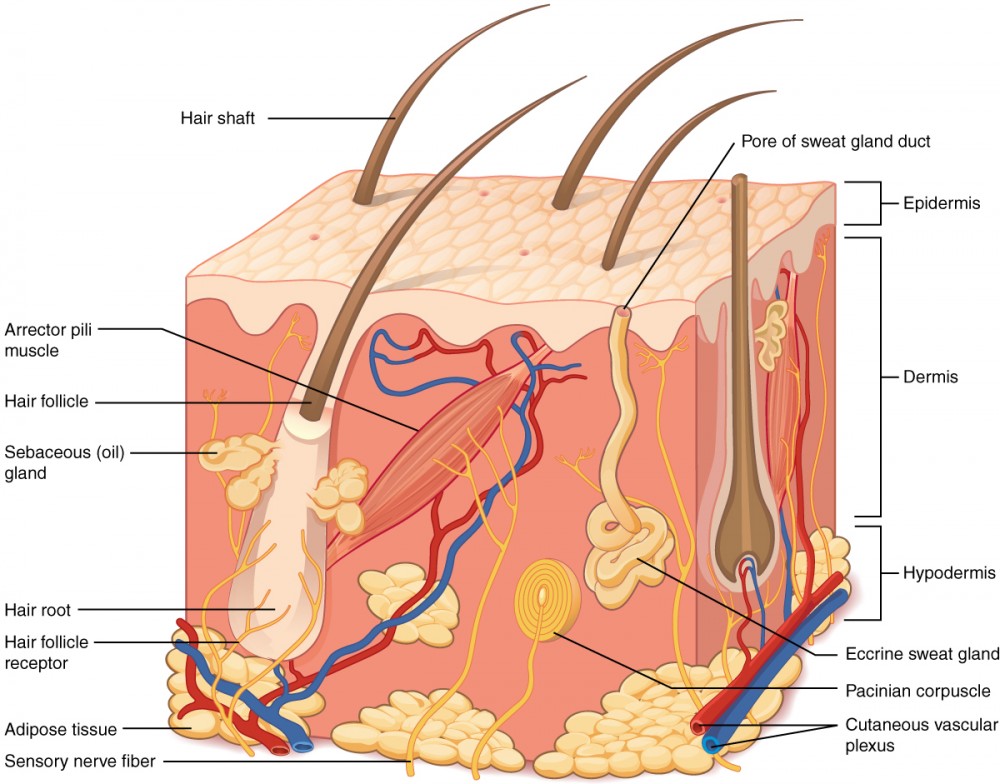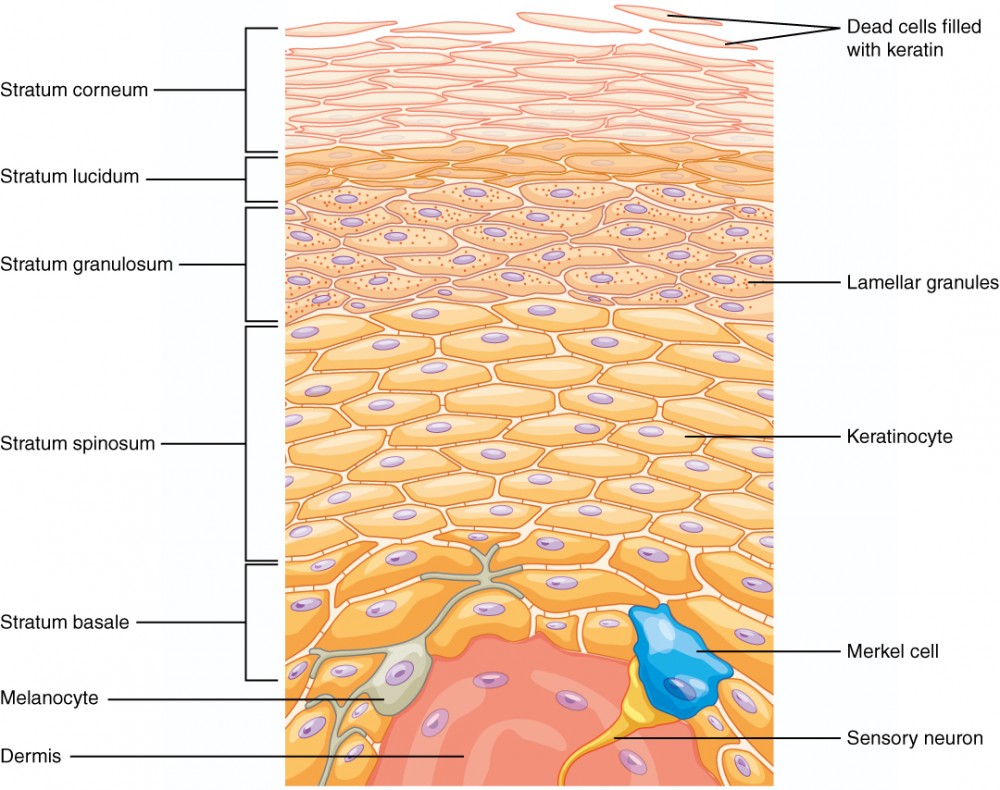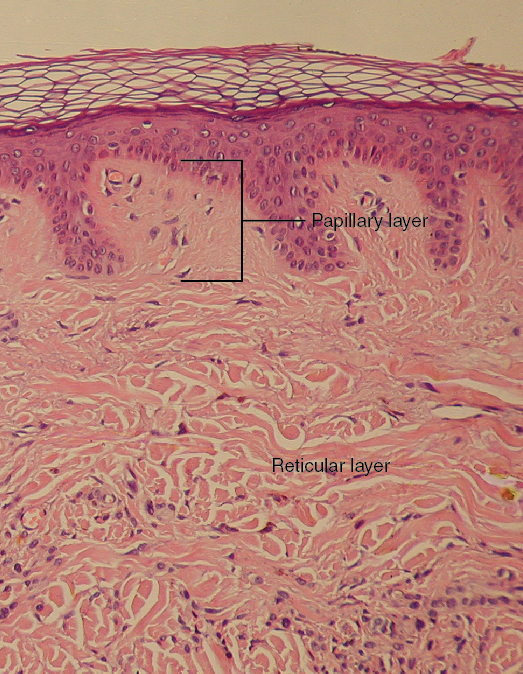Which Of The Following Is A Layer Of The Epidermis Found In Thin Skin?
Layers of the Skin
Learning Objectives
- Identify the components of the integumentary system
- Describe the layers of the pare and the functions of each layer
- Identify and describe the hypodermis and deep fascia
- Depict the role of keratinocytes and their life cycle
- Describe the role of melanocytes in peel pigmentation
- The Epidermis
- Stratum Basale
- Stratum Spinosum
- Stratum Granulosum
- Stratum Lucidum
- Stratum Corneum
- Dermis
- Papillary Layer
- Reticular Layer
- Hypodermis
Although yous may not typically think of the skin as an organ, it is in fact made of tissues that work together as a single structure to perform unique and critical functions. The skin and its accessory structures brand up the integumentary organisation , which provides the body with overall protection. The skin is made of multiple layers of cells and tissues, which are held to underlying structures by connective tissue (Effigy five.4). The deeper layer of skin is well vascularized (has numerous claret vessels). It also has numerous sensory, and autonomic and sympathetic nerve fibers ensuring communication to and from the encephalon.

The pare consists of 2 master layers and a closely associated layer. View this animation to learn more about layers of the skin. What are the basic functions of each of these layers?
The Epidermis
Theepidermis is composed of keratinized, stratified squamous epithelium. It is made of four or five layers of epithelial cells, depending on its location in the body. It does non have whatever claret vessels within it (i.east., it is avascular). Skin that has four layers of cells is referred to as "thin skin." From deep to superficial, these layers are the stratum basale, stratum spinosum, stratum granulosum, and stratum corneum. Most of the skin can be classified as sparse skin. "Thick skin" is found only on the palms of the easily and the soles of the anxiety. Information technology has a fifth layer, chosen the stratum lucidum, located between the stratum corneum and the stratum granulosum (Effigy 5.5).
The cells in all of the layers except the stratum basale are chosen keratinocytes. Akeratinocyte is a cell that manufactures and stores the poly peptide keratin.Keratin is an intracellular fibrous poly peptide that gives hair, nails, and skin their hardness and water-resistant properties. The keratinocytes in the stratum corneum are dead and regularly slough away, being replaced past cells from the deeper layers.

Stratum Basale
The stratum basale (also called the stratum germinativum) is the deepest epidermal layer and attaches the epidermis to the basal lamina, below which prevarication the layers of the dermis. The cells in the stratum basale bond to the dermis via intertwining collagen fibers, referred to as the basement membrane. The stratum basale is a unmarried layer of cells primarily made of basal cells. A basal cell is a cuboidal-shaped stem cell that is a precursor of the keratinocytes of the epidermis. All of the keratinocytes are produced from this single layer of cells, which are constantly going through mitosis to produce new cells. As new cells are formed, the existing cells are pushed superficially away from the stratum basale. 2 other cell types are establish dispersed amid the basal cells in the stratum basale. The beginning is a Merkel prison cell , which functions as a receptor and is responsible for stimulating sensory nerves that the brain perceives as touch. These cells are especially abundant on the surfaces of the hands and feet. The second is a melanocyte , a cell that produces the paint melanin. Melanin gives hair and skin its color, and also helps protect the living cells of the epidermis from ultraviolet (UV) radiation damage.
Stratum Spinosum
Every bit the name suggests, the stratum spinosum is spiny in appearance due to the protruding prison cell processes that join the cells via a construction called a desmosome . The desmosomes interlock with each other and strengthen the bond between the cells. It is interesting to note that the "spiny" nature of this layer is an artifact of the staining process. Unstained epidermis samples do not exhibit this characteristic appearance. The stratum spinosum is composed of 8 to 10 layers of keratinocytes, formed every bit a outcome of cell division in the stratum basale. Interspersed among the keratinocytes of this layer is a type of dendritic cell called the Langerhans cell , which functions as a macrophage by engulfing bacteria, strange particles, and damaged cells that occur in this layer.
The keratinocytes in the stratum spinosum brainstorm the synthesis of keratin and release a water-repelling glycolipid that helps forestall water loss from the torso, making the skin relatively waterproof. Every bit new keratinocytes are produced atop the stratum basale, the keratinocytes of the stratum spinosum are pushed into the stratum granulosum.
Stratum Granulosum
The stratum granulosum has a grainy appearance due to further changes to the keratinocytes as they are pushed from the stratum spinosum. The cells (3 to five layers deep) become flatter, their prison cell membranes thicken, and they generate big amounts of the proteins keratin, which is fibrous, and keratohyalin , which accumulates every bit lamellar granules within the cells (see Figure 5.v). These two proteins make up the bulk of the keratinocyte mass in the stratum granulosum and requite the layer its grainy appearance. The nuclei and other cell organelles atomize as the cells die, leaving behind the keratin, keratohyalin, and jail cell membranes that will grade the stratum lucidum, the stratum corneum, and the accessory structures of hair and nails.
Stratum Lucidum
The stratum lucidum is a smoothen, seemingly translucent layer of the epidermis located just above the stratum granulosum and beneath the stratum corneum. This thin layer of cells is found merely in the thick skin of the palms, soles, and digits. The keratinocytes that compose the stratum lucidum are dead and flattened (run into Figure 5.five). These cells are densely packed with eleiden , a clear protein rich in lipids, derived from keratohyalin, which gives these cells their transparent (i.e., lucid) appearance and provides a barrier to h2o.
Stratum Corneum
The stratum corneum is the nearly superficial layer of the epidermis and is the layer exposed to the exterior environment (see Effigy five.5). The increased keratinization (also called cornification) of the cells in this layer gives it its proper noun. In that location are commonly 15 to xxx layers of cells in the stratum corneum. This dry out, expressionless layer helps prevent the penetration of microbes and the dehydration of underlying tissues, and provides a mechanical protection against abrasion for the more than delicate, underlying layers. Cells in this layer are shed periodically and are replaced past cells pushed up from the stratum granulosum (or stratum lucidum in the case of the palms and soles of feet). The entire layer is replaced during a period of about 4 weeks. Corrective procedures, such every bit microdermabrasion, help remove some of the dry, upper layer and aim to keep the skin looking "fresh" and healthy.
Dermis
The dermis might be considered the "core" of the integumentary system (derma- = "pare"), as distinct from the epidermis (epi- = "upon" or "over") and hypodermis (hypo- = "beneath"). It contains claret and lymph vessels, nerves, and other structures, such as hair follicles and sweat glands. The dermis is mostly composed of dumbo irregular connective tissue that is divided to two layers: the papillary layer and reticular layer. Interwoven within these layers are numerous elastin and collagenous fibers, produced by fibroblasts (Figure five.six).

Papillary Layer
The papillary layer is the superficial layer of the dermis that projects into the stratum basale of the epidermis to form finger-like dermal papilla (plural = dermal papillae) (see Figure 5.6). Dermal papillae increase the forcefulness of the connection between the epidermis and dermis; the greater the folding, the stronger the connections made. Within the papillary layer are fibroblasts, a small-scale number of fat cells (adipocytes), and an abundance of capillary loops. In add-on, the papillary layer contains phagocytes, defensive cells that help fight leaner or other infections that take breached the peel. This layer too contains lymphatic capillaries, nerve fibers, and bear upon receptors called the Meissner corpuscles.
Reticular Layer
Underlying the papillary layer is the much thicker reticular layer . This layer is well vascularized and has a rich sensory and sympathetic nerve supply. The reticular layer appears reticulated (net-like) due to a tight meshwork of fibers.Elastin fibers provide some elasticity to the skin, enabling movement. Collagen fibers provide construction and tensile strength, with strands of collagen extending into both the papillary layer and the hypodermis. In addition, collagen binds water to keep the skin hydrated. Collagen injections and Retin-A creams help restore skin turgor by either introducing collagen externally or stimulating claret flow and repair of the dermis, respectively.
Hypodermis
The hypodermis (as well called the subcutaneous layer or superficial fascia) is a layer directly beneath the dermis and serves to connect the skin to the underlying fascia (gristly tissue) of the bones and muscles. It is not strictly a part of the skin, although the border betwixt the hypodermis and dermis can be difficult to distinguish. The hypodermis consists of well-vascularized, loose, areolar connective tissue and adipose tissue, which functions as a fashion of fatty storage and provides insulation and cushioning for the integument.
Everyday Connection: Lipid Storage
The hypodermis is home to most of the fat that concerns people when they are trying to go on their weight under control. Adipose tissue present in the hypodermis consists of fatty-storing cells called adipocytes. This stored fat can serve equally an energy reserve, insulate the body to prevent rut loss, and act every bit a cushion to protect underlying structures from trauma.
Where the fat is deposited and accumulates inside the hypodermis depends on hormones (testosterone, estrogen, insulin, glucagon, leptin, and others), as well equally genetic factors. Fatty distribution changes as our bodies mature and historic period. Men tend to accumulate fat in different areas (neck, artillery, lower back, and abdomen) than do women (breasts, hips, thighs, and buttocks). The trunk mass alphabetize (BMI) is often used as a measure of fat, although this measure out is, in fact, derived from a mathematical formula that compares body weight (mass) to height. Therefore, its accurateness as a health indicator can be chosen into question in individuals who are extremely physically fit.
In many animals, at that place is a pattern of storing excess calories as fat to be used in times when food is non readily available. In much of the developed world, insufficient exercise coupled with the fix availability and consumption of loftier-calorie foods have resulted in unwanted accumulations of adipose tissue in many people. Although periodic aggregating of excess fat may take provided an evolutionary reward to our ancestors, who experienced unpredictable bouts of famine, it is now becoming chronic and considered a major wellness threat. Recent studies indicate that a distressing percentage of our population is overweight and/or clinically obese. Not only is this a problem for the individuals afflicted, simply it also has a severe bear on on our healthcare system. Changes in lifestyle, specifically in diet and exercise, are the best ways to control torso fat aggregating, specially when it reaches levels that increase the take chances of heart disease and diabetes.
Source: https://courses.lumenlearning.com/nemcc-ap/chapter/layers-of-the-skin/
Posted by: brannanuncy1967.blogspot.com


0 Response to "Which Of The Following Is A Layer Of The Epidermis Found In Thin Skin?"
Post a Comment